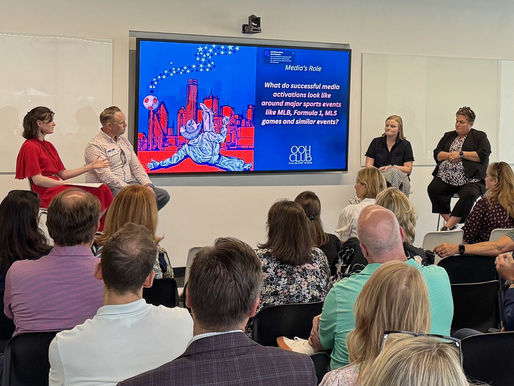top of page
OOH News from PJX Media
Get the latest news and insights from the world of Out-of-Home advertising and the PJX Media Team.


Figma Gets Visually Immersive with Out-of-Home Media
Web-based design tool Figma leveraged out-of-home advertising in San Francisco and New York to establish a strong brand presence. PJX streamlined the process of OOH media planning and buying, securing static and digital billboards and spectaculars.
2 min read


Sports and Out-of-Home Advertising, a Winning Combo!
Sports and Out-of-Home (OOH) advertising are a powerful team! OOH lets sports organizations - from pro teams to colleges - celebrate wins, promote games, and build hype for new seasons. It's a key play to excite fans and fill seats!
2 min read


DFW OOH Club Shines Spotlight on FIFA World Cup 2026 and the Region’s Explosive Growth
Last week, the DFW OOH Club discussed the future of sports, media, and economic development in North Texas. I co-moderated, highlighting how local media, especially OOH, will share DFW's story globally. The 2026 FIFA World Cup is a key moment, driving investment and visibility, which the OOH industry can't miss.
2 min read


Everand’s First-Ever OOH Campaign
PJX supported Everand's "Read Every Which Way," an out-of-home campaign in Portland, OR, targeting book-loving women near PSU and downtown. The variety of OOH formats, including wallscapes, wildpostings, transit, and more, made a strong brand statement in the market.
1 min read


Out-of-Home Complements Integrated Brand Campaign for LPL Financial
For its national ad campaign, LPL Financial launched the “What if you could” campaign. The imaginative storytelling and creativity is disruptive for a financial services brand, learn how PJX supported the campaign with out-of-home media.
1 min read


Programmatic DOOH Campaign for Visit Myrtle Beach
Learn how Visit Myrtle Beach leveraged programmatic digital out-of-home advertising for a multi-market campaign, complete with unique messaging/OOH ads per market.
1 min read


Leveraging QR Codes in Your Out-of-Home Ads
QR codes (Quick Response Codes) simplify information access. After they are scanned by smartphone users, they link to online content. Using them in out-of-home ads like bus shelters and other eye-level formats offers measurable engagement. Read our blog post for more info and best practices.
3 min read


Street Furniture Advertising: An Intro and Why It's Essential for Brands
Street furniture advertising (benches, bus shelters, kiosks, etc.) is a powerful form of OOH media. With eye-level connection and high dwell times, all brands need to be using this format.
5 min read


What goes into Out-of-Home (OOH) advertising?
There's a lot of care that goes into OOH advertising. New to the medium? Here is an outline that your brand or agency can follow for your next OOH campaign.
3 min read


Airport Security Trays take Fashion and Beauty Brands to New Heights
Out-of-home media formats in airports tap into a captive audience. Here are a few fashion and beauty brands using TSA airport security trays to elevate their branding.
2 min read


Vodka Brand Lights Up Times Square with Last-Minute OOH Activation
Meili Vodka leveraged a last-minute OOH campaign to light up Times Square, with attention-grabbing messaging. Read more!
1 min read


New Era Launches High-Impact OOH Campaign for Football Fans
PJX Media helped New Era with wrapped cars and dynamic 3D hologram at the 2025 NFL Draft. These branded vehicles, displaying team caps, reached 600K+ fans in Green Bay.
1 min read


Tommy John's OOH Ad Campaign Seizes the Moment to Support the New York Knicks
Lifestyle apparel brand Tommy John, based in New York City, made their support of the New York Knicks known with Digital Out-of-Home Advertising.
1 min read


OOH Measurement in a Perfect World
PJX attended the 2025 OAAA OOH Media Conference, “The Power of Presence” in Boston. CEO Rick Robinson moderated a discussion on the future of measuring OOH, we’re sharing key takeaways from the panel and a brief FAQ on OOH measurement.
3 min read


Central Health's Realtime Response with Programmatic DOOH
Programmatic Digital Out-of-Home (pDOOH) offers advertisers a quick and efficient solution to get their ads live. Read about our campaign to support Central Health's Measles vaccination campaign.
1 min read


OOH Tips for Travel and Tourism Brands
As Summer travel approaches, we touch on travel trends for the US and share some tips for brands looking to activate an OOH advertising campaign.
2 min read


Cost of Billboard Advertising in Times Square
Pricing for a billboard in the iconic Times Square area of New York City can vary. This quick guide will help you understand the basics.
2 min read


Out-of-Home Inventory Highlight: Shopping Malls
Shopping malls will continue to evolve into experience-focused hubs, extending beyond traditional retail to include cinema, dining, entertainment, and more. There are many OOH formats available at shopping malls including interior and exterior placements, traditional/static and digital.
2 min read


Brands Establish Presence at Elite Marathons with OOH Advertising
Using out-of-home (OOH) advertising around special events and moments allows your audience to create strong associations with your brand. PJX sourced OOH for 2 major running events globally. Learn more!
2 min read


American Defense Technology Company Leans into Out-of-Home Media for “Don’t Work” Recruitment Campaign
Leveraging bold creative and strategic out-of-home media, defense technology company Anduril launches a new recruitment campaign targeting Atlanta, Boston, and Seattle.
3 min read
bottom of page